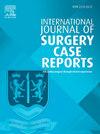Papillary endolymphatic sac tumor: Case report with clinical study and therapeutic management
IF 0.6
Q4 SURGERY
引用次数: 0
Abstract
Introduction and importance
Endolymphatic sac tumor (ELST) is a rare, histologically benign tumor with potentially aggressive behavior. Its management depends on the stage and extent of the disease.
Case presentation
We report the case of a 34-year-old male, with no significant medical history, presenting with progressive right-sided hearing loss, high-pitched tinnitus, and recurrent vertigo. Radiological assessment with CT and MRI revealed a hypervascular lesion centered on the petrous apex, with erosion of the internal auditory canal. A retrolabyrinthine surgical approach was performed. Histopathological examination confirmed a papillary tumor of the endolymphatic sac. Postoperative recovery was favorable, with no immediate neurological complications. Histological and immunohistochemical studies confirmed the diagnosis of ELST. Genetic testing for Von Hippel-Lindau (VHL) disease was negative.
Clinical discussion
ELSTs may occur sporadically or in association with Von Hippel-Lindau disease. Due to non-specific symptoms, imaging plays a crucial role in the diagnostic process. Surgery remains the mainstay of treatment to reduce the risk of recurrence, and the choice of surgical approach depends on several factors. The role of radiotherapy remains controversial. Long-term follow-up is essential to monitor for recurrence.
Conclusion
This report underscores the rarity of ELST and supports early surgical intervention due to its locally aggressive nature. Given the potential association with VHL syndrome, genetic screening is recommended even in apparently sporadic cases.
乳头状淋巴内囊瘤:1例临床研究及治疗管理
内淋巴囊瘤(ELST)是一种罕见的组织学良性肿瘤,具有潜在的侵袭行为。它的处理取决于疾病的阶段和程度。我们报告一例34岁男性,无明显病史,表现为进行性右侧听力丧失,高音耳鸣和复发性眩晕。CT和MRI影像学检查显示以岩尖为中心的血管增生病变,并伴有内耳道糜烂。行迷路后手术入路。组织病理学检查证实为内淋巴囊乳头状肿瘤。术后恢复良好,无立即神经系统并发症。组织学和免疫组织化学研究证实了ELST的诊断。Von Hippel-Lindau (VHL)病基因检测阴性。临床讨论:elsts可能零星发生或与希佩尔-林道病有关。由于非特异性症状,影像学在诊断过程中起着至关重要的作用。手术仍然是降低复发风险的主要治疗方法,手术方法的选择取决于几个因素。放射治疗的作用仍有争议。长期随访是监测复发的必要条件。结论本报告强调了ELST的罕见性,由于其局部侵袭性,支持早期手术干预。鉴于与VHL综合征的潜在关联,即使在明显散发的病例中也建议进行遗传筛查。
本文章由计算机程序翻译,如有差异,请以英文原文为准。
求助全文
约1分钟内获得全文
求助全文
来源期刊
CiteScore
1.10
自引率
0.00%
发文量
1116
审稿时长
46 days

 求助内容:
求助内容: 应助结果提醒方式:
应助结果提醒方式:


